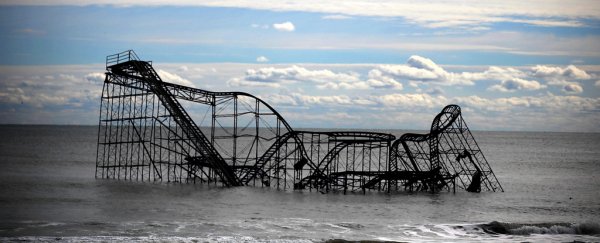Could a massive barrier erected in the ocean shield New York from the devastation of superstorm surges like Hurricane Sandy in 2012?
The truth is, nobody knows for sure, but a giant sea wall is nonetheless one serious proposal being looked at in a long-term research project designed to prevent a repeat of the deaths and destruction unleashed by the 2012 storm.
With a view to protecting the New York-New Jersey Harbour and Tributaries region from surges and flooding during powerful coastal storms – especially as sea levels rise due to climate change – the US Army Corps of Engineers is examining the feasibility of five different approaches to managing future flood risk in the area.
The multi-year study is only about halfway through its full assessment process, with the Corps expecting to release its final report and recommendations sometime in 2022.
But new media coverage of the research, and especially its most ambitious hypothetical measure – a giant sea wall estimated to cost almost US$119 billion, to be built over a massive 25-year timeframe – has drawn fresh scrutiny of the project, even from the top of American politics.
"A massive 200 Billion Dollar Sea Wall [sic], built around New York to protect it from rare storms, is a costly, foolish & environmentally unfriendly idea that, when needed, probably won't work anyway," US President Donald Trump tweeted on Sunday.
"It will also look terrible. Sorry, you'll just have to get your mops & buckets ready!"
While Trump's aversion to the proposed New York Harbour Storm-Surge Barrier is hardly surprising given his history on climate change and associated mitigation strategies, it's worth noting that many local voices are also critical of the plan.
The giant sea wall would comprise a series of connected surge gates connected by artificial islands, running approximately 9.6 kilometres (6 miles) in Lower New York Bay, in between Sandy Hook and the Rockaway Peninsula. As part of the plan, a smaller, separate barrier structure would also be built in the East River.
The project, called 'Alternative 2' in the Corps study, is the largest and most expensive of several hypothetical concepts to defend the New York region against future storm surges. The other alternatives encompass options for building smaller structures and barriers, including purely shoreline-based fortifications.
But while the sea wall is the biggest hypothetical barrier being looked at, there are grave fears it will prove inadequate to its task, since the entire structure, as massive and costly as it is, would only defend against storm surges, not rising sea levels themselves.
"These sea gates will not be able to protect communities from flooding caused by rising tides and rising sea levels, and once they're built, that's it," New York City comptroller Scott M. Stringer told The New York Times.
"We're not going to get the money again."
In a letter to the Corps researchers in October last year, Stringer thanked the engineers for their efforts in seeking to defend the city, but said the plans for offshore storm barriers showed a "myopic perspective" that would not address the complex, broader threats of rising waters and flooding due to climate change in the region.
In his own report, released in May 2019, Stringer advocated a range of alternative onshore resiliency projects to defend New York's 837 kilometres (520 miles) of exposed shorelines – including buying back property from vulnerable neighbourhoods, and expediting the use of funds allocated for Hurricane Sandy recovery, billions of which still remain unspent.
Others say a giant sea wall could also create unintended problems of its own in the harbour area, pointing to other similar barrier projects around the world, where the impeded passage of water, sediment, and marine life creates unforeseen environmental issues, including potentially trapping sewage and sludge.
"We'd essentially be sitting in a bathtub of our own excrement," senior attorney Kimberly Ong from environmentalist group the Natural Resources Defence Council told The Times.
The debate is expected to continue until 2022, when the US Army Corps of Engineers releases its final report for the US Congress, at which point more on the feasibility of all these options is hopefully clearer.
What's already apparent though is that taking no real action is not an option – not for New York, nor for any coastal cities around the world.
In his 'Safeguarding Our Shores' report, Stringer cited scientific estimates that sea levels around New York are expected to rise by up to 53 centimetres (21 inches) by 2050, just a few decades from now.
It's scary data like these that likely explain some actions Trump himself took a few years ago, securing the necessary permissions to protect a coastal golf resort he owns in Ireland: by building sea walls.
The Army Corps interim report is available here.
